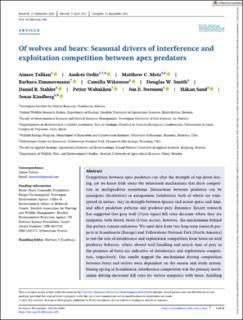Of wolves and bears: Seasonal drivers of interference and exploitation competition between apex predators
Tallian, Aimee Grace; Ordiz, Andres; Metz, Matthew C.; Zimmermann, Barbara; Wikenros, Camilla; Smith, Douglas W.; Stahler, Daniel R.; Wabakken, Petter; Swenson, Jon; Sand, Håkan; Kindberg, Jonas
Peer reviewed, Journal article
Published version
Date
2022Metadata
Show full item recordCollections
Abstract
Competition between apex predators can alter the strength of top-down forcing, yet we know little about the behavioral mechanisms that drive competition in multipredator ecosystems. Interactions between predators can be synergistic (facilitative) or antagonistic (inhibitive), both of which are widespread in nature, vary in strength between species and across space and time, and affect predation patterns and predator–prey dynamics. Recent research has suggested that gray wolf (Canis lupus) kill rates decrease where they are sympatric with brown bears (Ursus arctos), however, the mechanisms behind this pattern remain unknown. We used data from two long-term research projects in Scandinavia (Europe) and Yellowstone National Park (North America) to test the role of interference and exploitation competition from bears on wolf predatory behavior, where altered wolf handling and search time of prey in the presence of bears are indicative of interference and exploitation competition, respectively. Our results suggest the mechanisms driving competition between bears and wolves were dependent on the season and study system. During spring in Scandinavia, interference competition was the primary mechanism driving decreased kill rates for wolves sympatric with bears; handling time increased, but search time did not. In summer, however, when both bear and wolf predation focused on neonate moose, the behavioral mechanism switched to exploitation competition; search time increased, but handling time did not. Alternartively, interference competition did affect wolf predation dynamics in Yellowstone during summer, where wolves prey more evenly on neonate and adult ungulates. Here, bear presence at a carcass increased the amount of time wolves spent at carcasses of all sizes and wolf handling time for small prey, but decreased handling time for the largest prey. Wolves facilitate scavenging opportunities for bears, however, bears alter wolf predatory behavior via multiple pathways and are primarily antagonistic to wolves. Our study helps to clarify the behavioral mechanisms driving competition between apex predators, illustrating how interspecific interactions can manifest into population-level predation patterns.
Description
This is an open access article under the terms of the Creative Commons Attribution-NonCommercial-NoDerivs License, which permits use and distribution in any medium, provided the original work is properly cited, the use is non-commercial and no modifications or adaptations are made.
© 2022 The Authors. Ecological Monographs published by Wiley Periodicals LLC on behalf of Ecological Society of America.

